How Children Learn
- 格式:pdf
- 大小:183.39 KB
- 文档页数:32
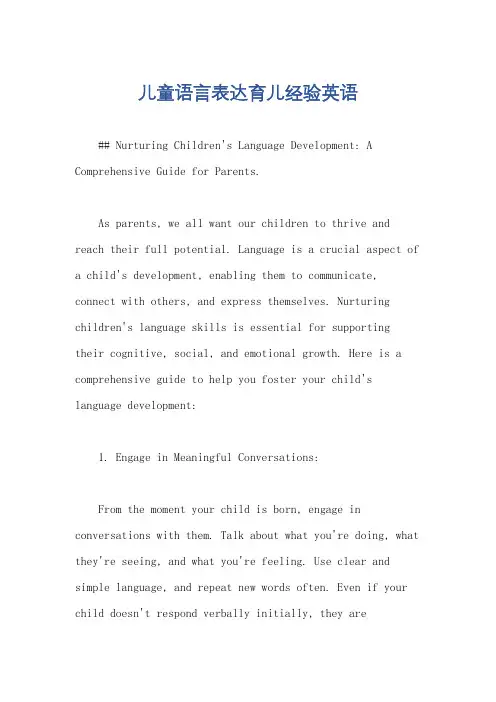
儿童语言表达育儿经验英语## Nurturing Children's Language Development: A Comprehensive Guide for Parents.As parents, we all want our children to thrive and reach their full potential. Language is a crucial aspect of a child's development, enabling them to communicate, connect with others, and express themselves. Nurturing children's language skills is essential for supportingtheir cognitive, social, and emotional growth. Here is a comprehensive guide to help you foster your child's language development:1. Engage in Meaningful Conversations:From the moment your child is born, engage in conversations with them. Talk about what you're doing, what they're seeing, and what you're feeling. Use clear and simple language, and repeat new words often. Even if your child doesn't respond verbally initially, they areabsorbing the sounds and patterns of speech.2. Read Aloud Regularly:Reading aloud to your child is one of the mosteffective ways to expose them to language. Choose booksthat are appropriate for their age and interests, and read with expression and enthusiasm. Point out new words, discuss the characters and plot, and ask your child questions about the story.3. Encourage Storytelling:Encourage your child to tell stories and share their experiences. Ask them open-ended questions to prompt their imagination and language skills. Provide positive reinforcement by listening attentively and asking follow-up questions. This helps them develop their narrative skills and confidence in expressing themselves.4. Provide Opportunities for Play:Play is a powerful tool for language development. Engage in imaginative play with your child, such as role-playing, building with blocks, or playing with toys. During play, children use language to create scenarios, solve problems, and interact with others.5. Model Correct Language:Children learn by imitating the language they hear around them. Model correct grammar, pronunciation, and vocabulary in your own speech. Avoid using baby talk or simplified language, as this can hinder their language development.6. Respond to Your Child's Vocalizations:Even before your child can speak, respond to their vocalizations by imitating them or offering simple responses. This encourages them to continue making sounds and eventually develop language.7. Create a Language-Rich Environment:Surround your child with a rich language environment. Talk to them during mealtimes, bathtimes, and other daily routines. Label objects, describe what you're doing, and encourage questions.8. Avoid Overcorrection:It's natural for children to make mistakes in their speech. Avoid overcorrecting them, as this can discourage them from speaking. Instead, gently repeat the correct pronunciation or grammar without making a fuss.9. Be Patient and Supportive:Language development takes time and varies from child to child. Be patient and supportive with your child. Provide them with plenty of opportunities to practice their language skills and celebrate their progress.10. Seek Professional Help if Needed:If you have concerns about your child's language development, don't hesitate to seek professional help. A speech-language pathologist can assess your child and provide personalized recommendations to support their language skills.Conclusion:Nurturing children's language development is a rewarding and fulfilling experience. By incorporating these strategies into your daily routine, you can create a stimulating and language-rich environment that will help your child reach their full potential as a communicator. Remember that every child develops at their own pace, so be patient, supportive, and enjoy the journey of fostering their language growth.。
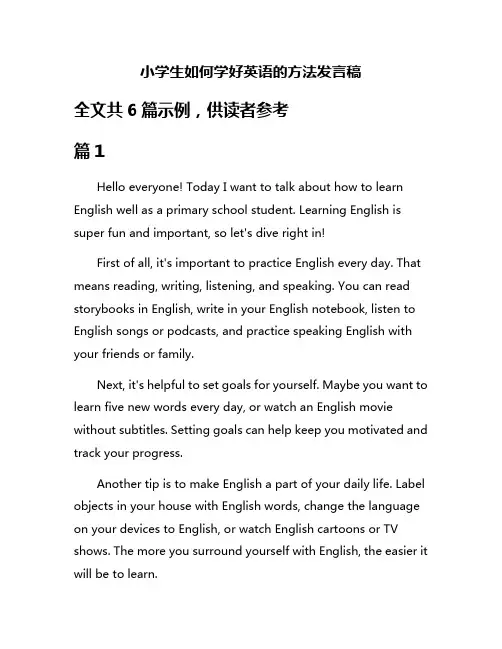
小学生如何学好英语的方法发言稿全文共6篇示例,供读者参考篇1Hello everyone! Today I want to talk about how to learn English well as a primary school student. Learning English is super fun and important, so let's dive right in!First of all, it's important to practice English every day. That means reading, writing, listening, and speaking. You can read storybooks in English, write in your English notebook, listen to English songs or podcasts, and practice speaking English with your friends or family.Next, it's helpful to set goals for yourself. Maybe you want to learn five new words every day, or watch an English movie without subtitles. Setting goals can help keep you motivated and track your progress.Another tip is to make English a part of your daily life. Label objects in your house with English words, change the language on your devices to English, or watch English cartoons or TV shows. The more you surround yourself with English, the easier it will be to learn.Don't be afraid to make mistakes! Learning a new language can be challenging, but it's okay to make errors. Mistakes are a part of the learning process, so don't be afraid to practice and improve.Lastly, have fun with it! Learning English can be exciting and rewarding. Try to find activities that you enjoy, such as playing English games, singing English songs, or even making English pen pals. The more you enjoy learning English, the more successful you'll be.So remember, practice every day, set goals, immerse yourself in English, embrace mistakes, and most importantly, have fun! Good luck on your English learning journey!篇2Hello everyone, my name is Sarah and today I want to share with you some tips on how to learn English well as a primary school student.First of all, it’s important to practice speaking English every day. You can do this by talking to your friends in English, watching English cartoons or even singing English songs. The more you practice, the better you will get!Secondly, make sure to read English books and listen to English stories. This will help you improve your vocabulary and comprehension skills. You can also try writing in English, like keeping a diary or writing letters to your pen pals.Another important tip is to pay attention in English class at school. Listen to your teacher and ask questions if you don’t understand something. It’s always okay to ask for help!Additionally, you can use online resources to learn English, like educational websites or apps. There are also fun games and videos that can help you practice your English skills in a fun way.Lastly, don’t be afraid to make mistakes. Learning a new language can be challenging, but it’s important to keep trying and never give up. Remember, practice makes perfect!In conclusion, by practicing speaking, reading, listening, paying attention in class, using online resources, and being persistent, you can definitely learn English well as a primary school student. Good luck and have fun learning! Thank you.篇3Hello everyone! Today, I want to share with you some tips on how to learn English well as a primary school student. Englishmay seem difficult at first, but with these tips, you can improve your English skills and become better at speaking, reading, and writing in English.First, it's important to practice English every day. You can start by listening to English songs, watching English cartoons or movies, and reading English books. The more you expose yourself to the language, the better you will become at it.Second, try to speak English as much as you can. Don't be afraid to make mistakes, because that's how you learn. You can practice speaking English with your friends, family, or even by yourself. The more you speak, the more confident you will become in using English.Third, make use of English learning apps and websites. There are many fun and interactive online resources that can help you improve your English skills. You can play games, take quizzes, and watch videos to practice your English in a fun way.Lastly, don't forget to review and revise what you have learned. Take notes, make flashcards, and do regular exercises to reinforce your English knowledge. With practice and dedication, you will definitely see improvements in your English skills.In conclusion, learning English can be fun and rewarding if you follow these tips. So, don't be afraid to try new things, make mistakes, and keep practicing. Good luck on your English learning journey! Thank you!篇4Hello everyone, I'm so excited to share with you all about how to learn English well as a primary school student! Learning English is super fun and can open up a whole new world for us, so let's get started!First of all, it's important to practice English every day. Whether it's reading a book, watching a movie, or talking to our friends in English, the more we use the language, the better we will become. Practice makes perfect, right?Next, we can also try using flashcards to learn new words. Write the English word on one side and the translation on the other side. We can quiz ourselves or ask our friends to help us remember the words. It's like a game!Another great way to learn English is to listen to English songs and try to sing along. Not only is it a fun way to practice our pronunciation, but we can also improve our listening skills. Plus, we can impress our friends with our singing talents!Lastly, don't be afraid to make mistakes. Learning a new language can be challenging, but it's okay to make mistakes along the way. Practice makes progress, and every mistake is just a stepping stone towards becoming fluent in English.So there you have it, my friends! Learning English can be super fun and rewarding if we put in the effort and practice every day. Let's keep learning and improving together! Thank you!篇5Good morning everyone! My name is Lucy and today I want to talk to you about how to learn English well. Learning English can be fun and exciting, so let's get started!First of all, it's important to practice English every day. You can talk to your friends in English, watch English movies or listen to English songs. The more you practice, the better you will get!Next, don't be afraid to make mistakes. Everyone makes mistakes, and that's okay! Just keep trying and you will improve.Also, try to learn new words every day. You can write them down in a notebook and review them regularly. This will help you to expand your vocabulary.Another tip is to find a study buddy. You can study together, practice speaking English with each other, and motivate each other to keep learning.Lastly, have fun with English! Find games, apps, or online resources that make learning English enjoyable. The more fun you have, the more you will want to practice.In conclusion, learning English can be easy and fun if you follow these tips. Practice every day, don't be afraid to make mistakes, learn new words, find a study buddy, and have fun with English. Remember, the more you practice, the better you will get! Thank you for listening.篇6Hello everyone, I'm so excited to talk to you today about how to learn English well as a primary school student! Learning English can be super fun and easy if we follow some tips and tricks. Let's get started!First of all, it's important to practice English every day. Just like how we do our homework every day, we should also spend some time reading, writing, and speaking in English. This can help us get better at English faster.Next, we can watch English cartoons or movies. This is a great way to learn English in a fun and entertaining way. We can listen to how the characters speak and try to imitate them. It's like having a English-speaking friend to practice with!Another tip is to play English games. There are lots of online games and apps that can help us improve our English skills. We can learn new words, practice grammar, and even chat with other players in English. It's a great way to make learning English feel like playtime!We can also join an English club at school or in our community. This is a great way to meet other students who are also learning English. We can practice speaking with each other, share tips and tricks, and even compete in English contests. Learning English together can be so much fun!Lastly, we can use flashcards to help us remember new words. We can write the English word on one side of the card and the Chinese word on the other side. We can quiz ourselves and try to remember the English word before flipping the card. It's a great way to build our vocabulary!In conclusion, learning English doesn't have to be hard or boring. By practicing every day, watching cartoons, playing games, joining a club, and using flashcards, we can improve ourEnglish skills and become fluent speakers. Let's keep learning and having fun with English! Thank you for listening.。
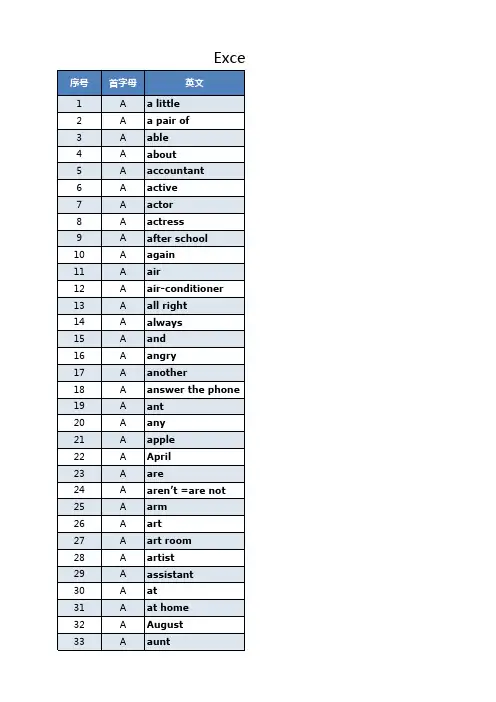
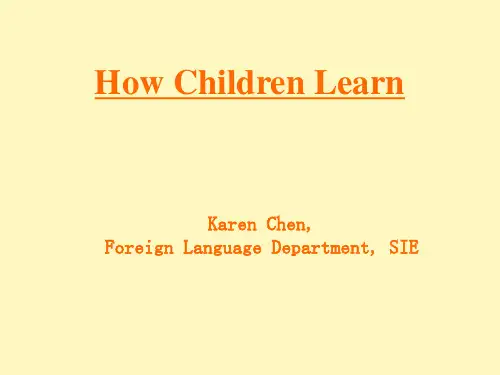
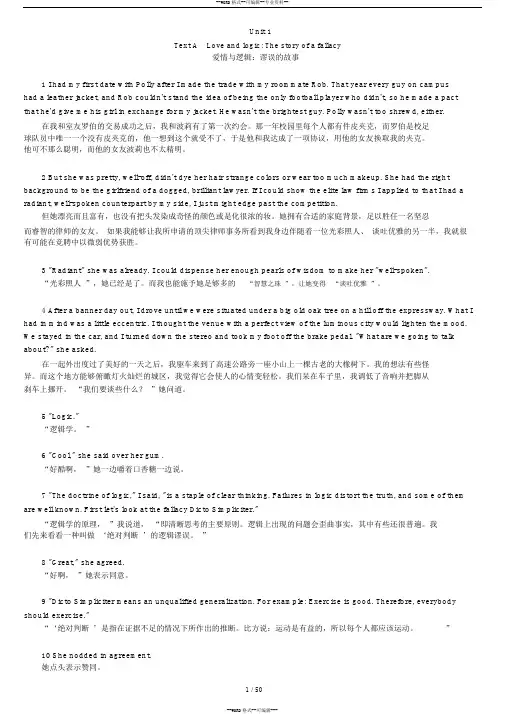
Unit 1Text A Love and logic: The story of a fallacy爱情与逻辑:谬误的故事1 I had my first date with Polly after I made the trade with my roommate Rob. That year every guy on campushad a leather jacket, and Rob couldn't stand the idea of being the only football player who didn't, so he made a pact that he'd give me his girl in exchange for my jacket. He wasn't the brightest guy. Polly wasn't too shrewd, either.在我和室友罗伯的交易成功之后,我和波莉有了第一次约会。
那一年校园里每个人都有件皮夹克,而罗伯是校足球队员中唯一一个没有皮夹克的,他一想到这个就受不了,于是他和我达成了一项协议,用他的女友换取我的夹克。
他可不那么聪明,而他的女友波莉也不太精明。
2 But she was pretty, well-off, didn't dye her hair strange colors or wear too much makeup. She had the right background to be the girlfriend of a dogged, brilliant lawyer. If I could show the elite law firms I applied to that I had a radiant, well-spoken counterpart by my side, I just might edge past the competition.但她漂亮而且富有,也没有把头发染成奇怪的颜色或是化很浓的妆。
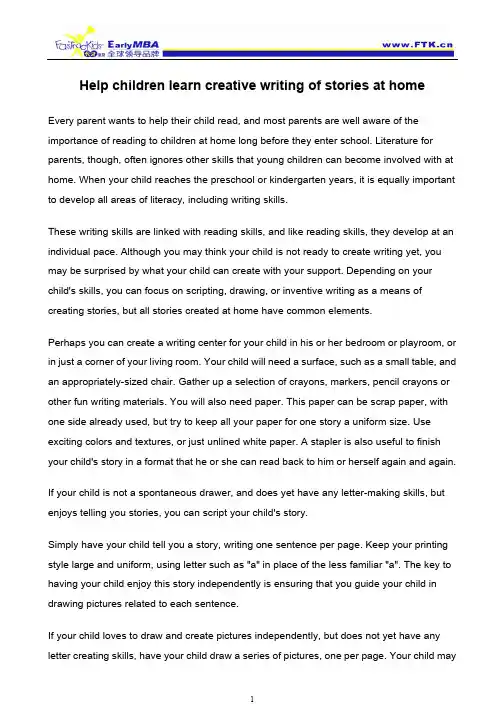
Help children learn creative writing of stories at homeEvery parent wants to help their child read, and most parents are well aware of the importance of reading to children at home long before they enter school. Literature for parents, though, often ignores other skills that young children can become involved with at home. When your child reaches the preschool or kindergarten years, it is equally important to develop all areas of literacy, including writing skills.These writing skills are linked with reading skills, and like reading skills, they develop at an individual pace. Although you may think your child is not ready to create writing yet, you may be surprised by what your child can create with your support. Depending on your child's skills, you can focus on scripting, drawing, or inventive writing as a means of creating stories, but all stories created at home have common elements.Perhaps you can create a writing center for your child in his or her bedroom or playroom, or in just a corner of your living room. Your child will need a surface, such as a small table, and an appropriately-sized chair. Gather up a selection of crayons, markers, pencil crayons or other fun writing materials. You will also need paper. This paper can be scrap paper, with one side already used, but try to keep all your paper for one story a uniform size. Use exciting colors and textures, or just unlined white paper. A stapler is also useful to finish your child's story in a format that he or she can read back to him or herself again and again.If your child is not a spontaneous drawer, and does yet have any letter-making skills, but enjoys telling you stories, you can script your child's story.Simply have your child tell you a story, writing one sentence per page. Keep your printing style large and uniform, using letter such as "a" in place of the less familiar "a". The key to having your child enjoy this story independently is ensuring that you guide your child in drawing pictures related to each sentence.If your child loves to draw and create pictures independently, but does not yet have any letter creating skills, have your child draw a series of pictures, one per page. Your child mayor may not wish to tell you a story while he or she is creating. Praise your child's work. When you feel that enough pages are completed to make a simple story, or the drawing session naturally ends, encourage your child to continue to the next step. Now, you can return to each picture and encourage your child to tell or re-tell a story to go with the pictures, scripting as you go.If your child has shown that he or she is able to write some letters, let your child have a try at some inventive writing. After your child has drawn a series of pictures for you, or after you have drawn a series of pictures for your child, have your child listen to some of the beginning sounds in one of the key words in a sentence. For example, if your child has drawn ‘Batman', talk about the ‘b' sound and what letter it makes. If your child comes up with ‘b', have him or write even that letter on the page. Do not consider where on the page or how these letters or words are written, just that they are recorded as your child is able.After your have continued through the length of your picture or sentence series, be sure to encourage your child to create a colorful title page, writing his or her name on it, if possible. Think of a fun title together. Be sure to staple or glue your child's story together in the form of a book. Be equally sure to have your child share this story, perhaps with another parent or adult. Let your child re-read this special story in the way he or she remembers it. This story will be a source of great joy for your child, and as well as developing reading, writing, phonics and drawing skills, will provide him or her with a memory of a time spent together.。
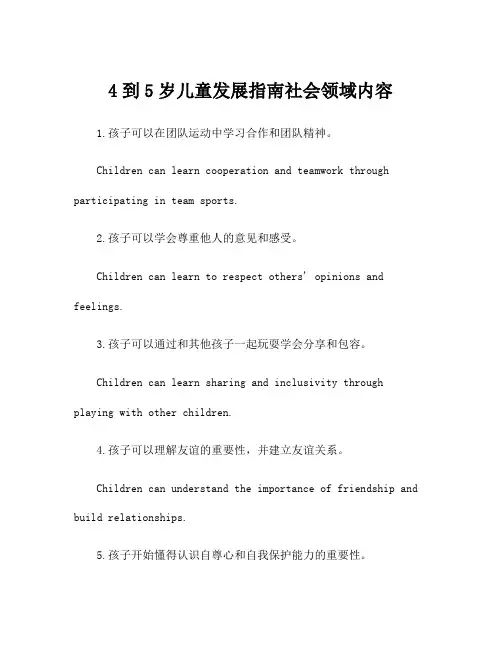
4到5岁儿童发展指南社会领域内容1.孩子可以在团队运动中学习合作和团队精神。
Children can learn cooperation and teamwork through participating in team sports.2.孩子可以学会尊重他人的意见和感受。
Children can learn to respect others' opinions and feelings.3.孩子可以通过和其他孩子一起玩耍学会分享和包容。
Children can learn sharing and inclusivity through playing with other children.4.孩子可以理解友谊的重要性,并建立友谊关系。
Children can understand the importance of friendship and build relationships.5.孩子开始懂得认识自尊心和自我保护能力的重要性。
Children start to understand the importance of self-esteem and self-protection.6.孩子可以在幼儿园或学前教育中培养独立性和自理能力。
Children can develop independence and self-care skills in kindergarten or preschool.7.孩子可以学习尊重他人的私人空间和财物。
Children can learn to respect others' personal space and belongings.8.孩子可以通过角色扮演和游戏学习如何与他人互动和沟通。
Children can learn how to interact and communicate with others through role-playing and games.9.孩子开始理解规则的重要性,并学会遵守规则。
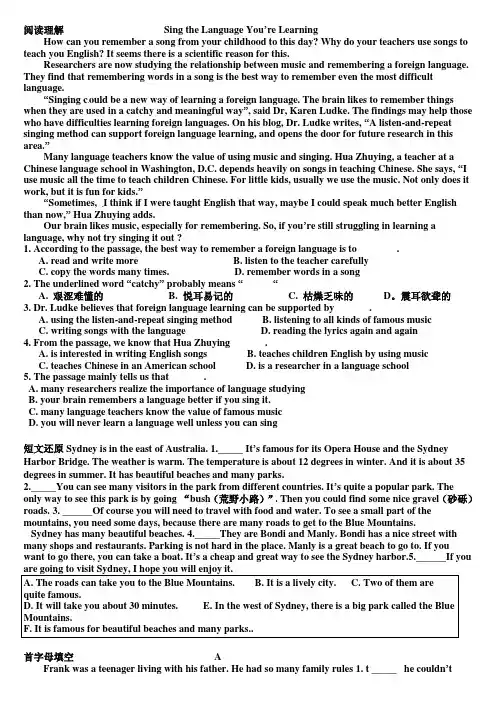
阅读理解Sing the Language You’re LearningHow can you remember a song from your childhood to this day? Why do your teachers use songs to teach you English? It seems there is a scientific reason for this.Researchers are now studying the relationship between music and remembering a foreign language. They find that remembering words in a song is the best way to remember even the most difficult language.“Singing c ould be a new way of learning a foreign language. The brain likes to remember things when they are used in a catchy and meaningful way”, said Dr, Karen Ludke. The findings may help those who have difficulties learning foreign languages. On his blog, Dr. Ludke writes, “A listen-and-repeat singing method can support foreign language learning, and opens the door for future research in this area.”Many language teachers know the value of using music and singing. Hua Zhuying, a teacher at a Chinese language school in Washington, D.C. depends heavily on songs in teaching Chinese. She says, “I use music all the time to teach children Chinese. For little kids, usually we use the music. Not only does it work, but it is fun for kids.”“Sometimes, I think if I were taught English that way, maybe I could speak much better English than now,” Hua Zhuying adds.Our brain likes music, especially for remembering. So, if you’re still struggling in learning a language, why not try singing it out ?1. According to the passage, the best way to remember a foreign language is to .A. read and write moreB. listen to the teacher carefullyC. copy the words many times.D. remember words in a song2. The underlined word “catchy” probably means ““A. 艰涩难懂的B. 悦耳易记的C. 枯燥乏味的D。

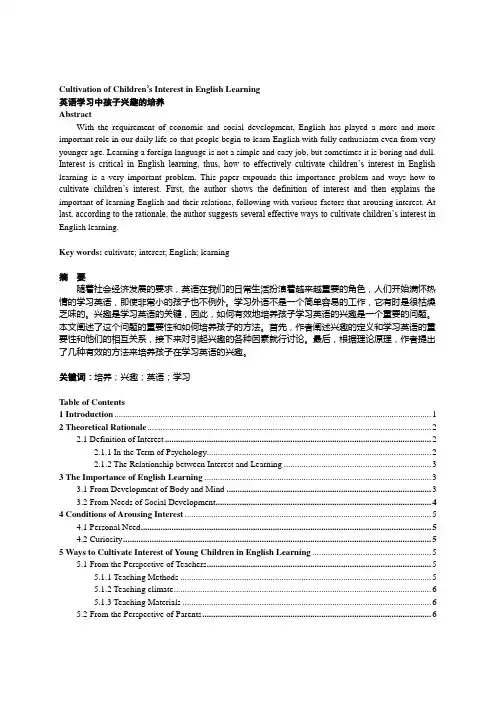
Cultivation of Children’s Interest in English Learning英语学习中孩子兴趣的培养AbstractWith the requirement of economic and social development, English has played a more and more important role in our daily life so that people begin to learn English with fully enthusiasm even from very younger age. Learning a foreign language is not a simple and easy job, but sometimes it is boring and dull. Interest is critical in English learning, thus, how to effectively cultivate children’s interest in English learning is a very important problem. This paper expounds this importance problem and ways how to cultivate children’s interest. First, the author shows the definition of interest and then explains the important of learning English and their relations, following with various factors that arousing interest. At last, according to the rationale, the author suggests several effective ways to cultivate children’s interest in English learning.Key words: cultivate; interest; English; learning摘要随着社会经济发展的要求,英语在我们的日常生活扮演着越来越重要的角色,人们开始满怀热情的学习英语,即使非常小的孩子也不例外。
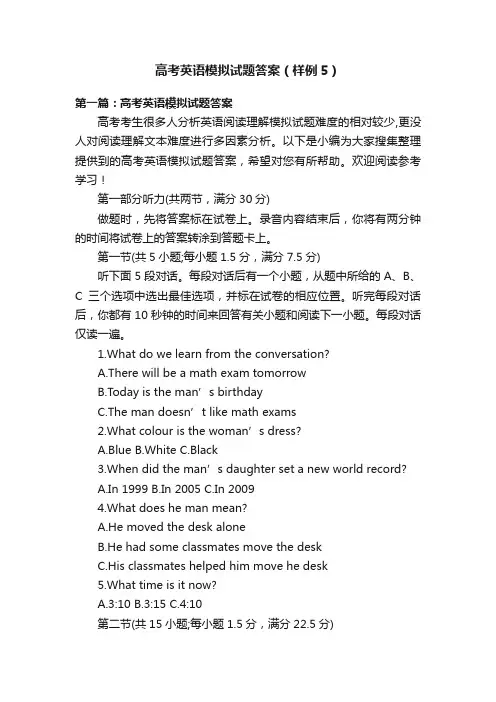
高考英语模拟试题答案(样例5)第一篇:高考英语模拟试题答案高考考生很多人分析英语阅读理解模拟试题难度的相对较少,更没人对阅读理解文本难度进行多因素分析。
以下是小编为大家搜集整理提供到的高考英语模拟试题答案,希望对您有所帮助。
欢迎阅读参考学习!第一部分听力(共两节,满分30分)做题时,先将答案标在试卷上。
录音内容结束后,你将有两分钟的时间将试卷上的答案转涂到答题卡上。
第一节(共5小题;每小题1.5分,满分7.5分)听下面5段对话。
每段对话后有一个小题,从题中所给的A、B、C三个选项中选出最佳选项,并标在试卷的相应位置。
听完每段对话后,你都有10秒钟的时间来回答有关小题和阅读下一小题。
每段对话仅读一遍。
1.What do we learn from the conversation?A.There will be a math exam tomorrowB.Today i s the man’s birthdayC.The man doesn’t like math exams2.What colour is the woman’s dress?A.BlueB.WhiteC.Black3.When did the man’s daughter set a new world record?A.In 1999B.In 2005C.In 20094.What does he man mean?A.He moved the desk aloneB.He had some classmates move the deskC.His classmates helped him move he desk5.What time is it now?A.3:10B.3:15C.4:10第二节(共15小题;每小题1.5分,满分22.5分)听下面5段对话或独白。
每段对话或独白后有几个小题,从题中所给的A、B、C三个选项中选出最佳选项,并标在试卷的相应位置。
小孩是否应该在年幼时学习英语?Should ChildrenLearn English in a Young Age?With the increasing of social competition, peoplepay more and more attention on the young generation. Especially their parentswill take every means to help their children get prepared for adapting thesociety. Thus, learning English in a very young age becomes very common amonglittle children. Some people agree with it, but some hold the opposite view. Inmy opinion, parents should not force their children to study English in a veryyoung age.随着社会竞争的增加,人们越来越重视年轻一代。
特别是他们的父母会竭尽全力去帮助他们的孩子做好适应社会的准备。
因此,在年幼时学习英语在小孩子中变得很普遍。
有些人同意这个观点,有些人则反对。
在我看来,父母不应该强迫他们的孩子在比较小的时候就开始学习英语。
To begin with, children in a young ageshould live happily, instead of gaining burden. Childhood plays a veryimportant role in one’s whole life, because it takes up a part in his innermind. A child having a happy childhood may be a sunshine boy, when he grows up.But a child carry a heavy burden inhis childhood, he may be pessimistic in thefuture. And learning English in a young age is no doubt to deprive children’shappy childhood. How can they be happy to be enforced to learn something theydon’t like? Grow up healthily is more important to a person.首先,年幼的小孩应该过得开开心心,而不是背上负担。
二.主要研究成果Chapter 3. The linguistics of SLAⅠ. The nature of languageⅡ. Early approaches to SLA1.Contrastive Analysis (CA)1). as a beginning of the survey:aspects of its procedures are still incorporated in more recent approaches.It introduced the influence of L1 on L2 (Chomsky)—2). CA: an approach to the study of SLA which involves predicting and explaininglearner problems based on a comparison of L1 and L2 to determine similarities and differences.(Based on idealized linguistic structures attributed to native speakers of L1 and L2)3). influenced by Structuralism and Behaviorism.4). Goal of CA was primarily pedagogical in nature: to increase efficiency in L2teaching and testing.5). Process:Describing L1 and L2 at different levelAnalyzing comparable segment of the language for elements that may cause Types of interference Examples]same form and meaning; different distribution la s paloma s blanca s (Spanish) the white dove ssame meaning; different form kittie s 小猫们same meaning;different form and distribution 、water (n. v.)水(名)different form; legpartial overlap in meaning 腿,蹄,下肢similar form; different meaning asistir (Spanish “to attend”) assist (English “to help”):6). Assessment:Cannot explain the logical problem of language learning (how learners knowmore than they’ve heard and been taught)Not always validated by evidence from actual learner errors.Stimulated the preparation of comparative grammarIts analytic procedures have been usefully applied to descriptive studies andto translation2.Error analysis (EA)1). EA: the first approach to the study of SLA which includes an internal focus onlearner’s creative ability to construct language.(based on the description and analysis of actual learner errors in L2)2). CA→EAPredictions by CA not always correct; many real learner errors are not transferred from L1!Focus on surface-level forms and patterns→underlying rulesBehaviorism→mentalism (emphasis on the innate capacity)Teaching concerns as motivation↓3). Procedures for analyzing learner errors:Collection of a sample of learner languageIdentification of errorsDescription of errorsExplanation of errorsEvaluation of errors4). Shortcomings'Ambiguity in classificationLack of positive dataPotential for avoidance3.Interlanguage (IL)1). IL refers to the intermediate states (interim grammars) of a learner’s languageas it moves toward the target L2.2). Characteristics:SystematicDynamicVariableReduced system, both in form and function|3). Differences between SLA and L1 acquisition by childrenLanguage transfer from L1 to L2Transfer of training, or how the L2 is taughtStrategies of 2nd language learningOvergeneralization of the target language linguistic materials4). L1 as fossilization for L2 learners:Fossilization: the probability that they’ll cease their IL development in some respects before they reach target language norms, in spite of continuing L2 input and passage time.Relates to: the age of learning; social identity; communicative need.4.Morpheme order studies1). Refers to:an important Q in the study of SLA, whether there is a naturalorder (or universal sequence) in the grammatical development of L2 learners.)2). Inflection: it adds one or more units of meaning to the base form of a word, togive it a more specific meaning. (plural nouns, past tense etc.)3). The order of morpheme acquisition reported was similar in L1 and L2It supports an Identity Hypothesis (L1=L2): that processes involved in L1 and L2 acquisition are the same.4). The concept of natural order remains very important for understanding SLA.(both from linguistic and cognitive approaches)5.Monitor model1). One of the last of the early approaches which has an internal focus in theMonitor Model.(Stephen Krashen)2). It explicitly and essentially adopts the notion of a language acquisition device(LAD) (Chomsky used for children’s innate knowledge of language)3). Krashen’s approach: 5 hypotheses6.Consensus:~1). What is being acquired in SLA is a “rule0governed” language systems2). How SLA take place involves creative mental processes.3). Why some learners are more (less) successful in SLA than others relatesprimarily to the age of the learner.Ⅲ. Universal Grammar (UG)1.UG (Chomsky): what all languages have in common.1). Two important conceptslinguistic competence (speaker-hearers’underlying knowledge of language) needs to be accounted for LAsuch knowledge of language > what could be learned from the input. (the logic problem of language learning/ the poverty-of-the stimulus argument)2). The nature of speaker-hearers’competence in native language can beexplained only by innate knowledge that human genetically endowed with.3). The innate knowledge is in the language faculty|Language faculty: a component of the human mind, physically represented in the brain and part of the biological endowment of the species.2.Principles and Parameters1). With Chomsky’s reconceptualization of UG in the Principles and Parametersframework [often called the Government and Binding (GB) model] and the subsequent introduction of the Minimalist program, there came a new idea about the acquisition process.2). UG has been conceptualized as a set of principles which are properties of alllanguages in the world.Some of these principles contain parameters3). What is acquired in L1 acquisition (not UG itself):LA includes a process of selecting among the limited parametric options in UG that match the settings which are encountered in linguistic input.4). How acquisition occurs for children:natural; instinctive; internal to the cognitive system5). Why some learners are more successful:【Irrelevant with L1 acquisition, for all native speakers attain essentially the same final state. (For SLA, attitudes; motivation and social context matters)States UG SLAInitial state Make parametric choicesthat are appropriate forL1 (Guided by UG)L1 transferNature and developmentof interlanguage;Final state Native language;same Why more successful relevant to L2:The degree of access to UGRelationships between L1&L2→differential transfer orinterferenceL2 input qualityDegree of perceptionDegree of specification forlexical features)Ⅳ. Functional approaches1.Functional approach1). Based on: the framework of Functionalism2). Characteristics of functional approaches to SLAFocus on the use of language in real situations (performance) and underlying knowledge (competence)Assumption: purpose of language is communication; LA and SLA require communicative useConcern about the sentence, discourse structure, how language is used in interaction; include aspects of communication beyond language Systemic linguistics Systemic linguistics is a model for analyzing language in terms of the interrelated systems of choices that are available for expressing meaning.》“language acquisition needs to be seen as the mastery of linguistic functions”2). What language learners acquire: meaning potential3). Process of acquisition:mastering certain basic functions of languagedeveloping a meaning potential for each4). pragmatic functions development in L1 acquisition:instrumental→regulatory→interactional→personal→heuristic→imagination→representational5). linguistic structures: directly reflections of the functions that language serves;related to the social and personal needs2.Functional Typology1). Based on: the comparative study of a wide range of the world’s language,2). Goal: to describe patterns of similarities and differences among languages; todetermine which types and patterns occur more/less frequently or are universal in distribution.3). Application: why some L2 constructions are more/less difficult than others forL2 learners to acquire; for the selectivety of crosslinguistic influence or transfer4). important concept: markedness (deals with whether any specific feature oflanguage is marked or unmarked)Feature in L1 Feature in L2 PredictionMarked Unmarked (common) L2 feature will be easy to learn> L1 feature will not transfer to L2Unmarked Marked L1 feature will transfer to L2In SLA, unmarked elements are easier to master than marked ones.6). Compared with CA:Functional typology goes beyond the surface-level structural (CA) to moreabstract patterns, principles and constraints;-the Markedness Differential Hypothesis7). implications:some aspects of some languages are more difficultwhy some types and patterns of features are more/less frequent in nativeand 2nd language (factors: perceptual salience, ease of cognitive processing,physical constraints, communicative needs)3.Function-to-form mapping1). Basic concept: L1 and L2 acquisition involves a process of grammaticalization.2). Grammaticalization: a grammatical function is first conveyed by sharedextralinguistic knowledge and inferencing based on the context of discourse, then by a lexical word, and only later by a grammatical marker.Driven by: communicative need and use.Related to : the development of more efficient cognitive process3). Pragmatic mode: a style of expressing meaning which relies more on context.Syntactic mode: a style which relies more on formal grammatical element4). According to function-to-mapping approach, LA importantly involvesdeveloping linguistic forms to fulfill semantic or pragmatic functions.rmation organization1). Focus on: utterance structure (the way learners put their words together.)2). Includes:describing the structures of interlanguage (learner varieties)discovering what organizational principles guide learners’production at various stages of developmentanalyzing how these principles interact with one another.3). European Science Foundation (ESF) projectdevelopmental levels: in this study, no matter what their L1 and L2, the learners go through a remarkably similar sequence of development in their interlanguage.organizing principles:*there is a limited set of principles (phrasal constraints; semantic constraints; pragmatic constraints) which learners make use of fororganizing information.*Individual variation: how the principles apply in their L1 and influence the interlanguage use.。
幼儿发展指南游戏的重要性英文回答:Play is a central part of early childhood development. It provides children with opportunities to learn and grow in all areas of development, including physical, cognitive, social, and emotional skills.Physical development.Play helps children develop their gross motor skills, such as running, jumping, and climbing. It also helps them develop their fine motor skills, such as grasping objects, scribbling, and building with blocks.Cognitive development.Play helps children learn about the world around them. They can explore different objects, materials, and ideas through play. They can also develop their problem-solvingskills, creativity, and imagination.Social development.Play helps children learn how to interact with others. They can learn how to cooperate, share, and take turns. They can also develop their empathy and compassion.Emotional development.Play can help children express their emotions in a healthy way. They can learn how to cope with stress, anger, and frustration. They can also learn how to build self-esteem and confidence.Importance of play in early childhood development.Play is essential for the healthy development of young children. It provides them with opportunities to learn, grow, and socialize. It also helps them develop their physical, cognitive, social, and emotional skills.How to encourage play in young children.There are many ways to encourage play in young children. Parents and caregivers can provide children with toys and materials that encourage play. They can also create a safe and supportive environment where children feel comfortable exploring and playing.中文回答:幼儿发展指南中游戏的意义。
观看半月谈如何让孩子爱上学习观后感After watching the program "Half-Monthly Talks," how can we make children love learning? Here are a few suggestions to inspire children's passion for learning.Engage them in meaningful activities outside the classroom. Encourage children to explore their interests and hobbies by participating in various extracurricular activities, such as sports, music, art, or community service. These activities can provide new experiences and perspectivesthat make learning more enjoyable.通过参与有意义的课外活动让孩子们投入其中。
鼓励孩子们探索自己的兴趣和爱好,比如参加体育、音乐、艺术或社区服务等各种课外活动。
这些活动可以提供新的经验和观点,使学习更加有趣。
Introduce real-world connections to academic subjects. Help children understand the practical applications of what they learn in school. Connect abstract concepts with real-life examples and show how knowledge can be applied in different situations. This can make learning more relevant andmeaningful for children.将现实世界与学科相结合。
如何帮孩子学会英语作文帮助孩子学会英语是许多家长和老师共同的心愿。
下面是一篇高质量的英语作文,以如何帮助孩子学会英语为主题,希望对你有所启发。
Title: How to Help Children Learn English。
Learning English is crucial for children in today's globalized world. As parents and educators, it's our responsibility to facilitate this process and make it enjoyable for them. Here are some effective strategies to help children learn English:1. Start Early: Introduce English to children from a young age. Children have a remarkable ability to absorb languages, so exposing them early gives them a head start. Utilize resources like English storybooks, songs, and educational apps designed for their age group.2. Create an English-Speaking Environment: Surroundchildren with English as much as possible. Speak to them in English at home, watch English cartoons or movies together, and encourage them to interact with English-speaking peers. Immersion is key to language acquisition.3. Make Learning Fun: Incorporate games, activities,and interactive lessons to make learning English enjoyable. Use flashcards for vocabulary, play language learning apps, or engage in role-playing activities where they canpractice speaking English in different scenarios.4. Set Realistic Goals: Break down English learninginto manageable goals. Celebrate their achievements,whether it's learning new words, completing a book, or holding a conversation in English. Positive reinforcement encourages continued effort.5. Consistency is Key: Establish a regular English learning routine. Set aside dedicated time each day for English practice, whether it's reading, listening, speaking, or writing. Consistency helps reinforce learning and builds fluency over time.6. Encourage Reading: Reading is fundamental to language development. Provide children with a variety of English reading materials such as storybooks, comics, magazines, and newspapers. Encourage them to read aloud to improve pronunciation and comprehension.7. Utilize Technology: Leverage technology to enhance English learning. There are numerous educational websites, apps, and online resources tailored for children, offering interactive lessons, games, and exercises to improve their English skills.8. Be Patient and Supportive: Learning a new language takes time and patience. Encourage children to embrace mistakes as part of the learning process and provide gentle guidance and support along the way. Encourage them to practice regularly and offer praise for their efforts.9. Cultural Immersion: Introduce children to English-speaking cultures through music, films, food, and traditions. This not only enriches their language learningexperience but also fosters cross-cultural understanding and appreciation.10. Lead by Example: Show children the importance of English proficiency by demonstrating your own enthusiasm for the language. Engage in conversations with them in English, read English books together, and showcase how English can open doors to new opportunities.In conclusion, helping children learn English requires a combination of patience, creativity, and consistency. By creating a supportive environment, incorporating fun activities, and leveraging various resources, we can empower children to become confident English speakers and equip them with a valuable skill for their future success.。
parents should learn how to praise children's good 1. 引言概述:父母在孩子成长过程中扮演着重要的角色,他们的行为方式和态度对孩子的发展起着决定性的影响。
其中,表扬是一种激励和肯定孩子积极行为和努力的方式。
然而,很多父母常常忽视了正确表扬孩子所带来的益处。
本文旨在探讨父母应该如何学会表扬孩子的优点,并强调正确表扬对于孩子发展的重要作用。
文章结构:本文将从以下几个方面来讨论父母学会如何表扬孩子的优点:1) 父母应该学习并理解表扬的重要性。
2) 描述正确方法以及适当的时机和方式来表扬孩子。
3) 探讨表扬对孩子整体发展产生的积极影响。
4) 鼓励父母关注并赞赏孩子在日常生活中取得小进步和付出努力。
5) 强调不使用过于功利性且虚假夸大其词的表扬方式,并提倡使用真诚具体肯定语言去称赞孩子。
6) 探讨维持积极沟通并建立良好亲子关系的重要性。
7) 总结全文。
目的:本文的目标在于向父母传达正确表扬孩子优点的必要性和重要性。
通过学习和掌握正确的表扬技巧,父母可以促使孩子树立正确的自我认知,增强孩子自信心,并且助力他们在成长过程中取得更好的发展。
同时,通过这种有效的表扬方式,还能够培养积极向上、乐观进取的心态,构建更为良好、稳固的亲子关系。
2. 父母应该学会如何表扬孩子的优点:2.1 表扬的重要性:表扬是一种积极的肯定行为,对孩子的发展具有重要影响。
通过表扬,父母可以增强孩子的自尊心和自信心,激发他们的内在动力,并提高他们对自己能力和价值的认知。
适当的表扬可以建立良好的家庭氛围,在家庭中树立积极向上、乐观向前的价值观。
2.2 表扬的正确方式:父母在表扬孩子时应注意正确方式。
首先,表扬应该真诚和具体,不是简单地使用模糊而空洞的赞美语言。
例如,当孩子完成了一项任务时,可以说:“你做得很棒!你很用心地完成了作业,我为你感到骄傲。
”其次,父母应该时刻关注并倾听孩子所说和所做的事情,并及时予以表扬和肯定。
E D U C A T I O N A L P R A C T I C E S S E R I E S –7The International Academyof EducationThe International Academy of Education (IAE) is a not-for-profit scientific association that promotes educational research, its dissemination, and the implementation of its implications. Founded in 1986, the Academy is dedicated to strengthening the contributions of research, solving critical educational problems throughout the world, and providing better communication among policy makers, researchers and practitioners. The seat of the Academy is at the Royal Academy of Science, Literature and Arts in Brussels, Belgium, and its co-ordinating centre is at Curtin University of Technology in Perth, Australia.The general aim of the IAE is to foster scholarly excel-lence in all fields of education. Towards this end, the Academy provides timely syntheses of research-based evidence of international importance. The Academy also provides critiques of research, its evidentiary basis, and its application to policy.The current members of the Board of Directors of the Academy are:•Erik De Corte, University of Leuven, Belgium (President)•Herbert Walberg, University of Illinois at Chicago, United States of America (Vice President)•Barry Fraser, Curtin University of Technology, Australia (Executive Director)•Jacques Hallak, Paris, France•Michael Kirst, Stanford University, United States of America•Ulrich Teichler, University of Kassel, Germany •Margaret Wang, Temple University, United States of America.au/curtin/dept/smec/iaePrefaceThis booklet is about how children learn. It has been prepared for inclusion in the Educational Practices Series developed by the International Academy of Education and distributed by the International Bureau of Education and the Academy. As part of its mission, the Academy provides timely syntheses of research on educational topics of international importance. This book-let is the seventh in the series on educational practices that generally improve learning.The author is Stella Vosniadou, who has written many arti-cles and books in the area of cognitive, developmental and educational psychology. She has taught at the University of Illinois in Urbana-Champaign and at the University of Athens, and was president of the European Association for Research on Learning and Instruction. She is currently the director of a grad-uate programme in cognitive science in the Department of Philosophy and History of Science at the University of Athens.The officers of the International Academy of Education are aware that this booklet is based on research carried out prima-rily in economically advanced countries. The booklet, however, focuses on aspects of how children learn that appear to be universal in much formal and informal schooling. The practices presented here are likely to be generally applicable through-out the world. Even so, the principles should be assessed with reference to local conditions, and adapted accordingly. In any educational setting or cultural context, suggestions or guide-lines for practice require sensitive and sensible application, and continuing evaluation.HERBERT J. WALBERGEditor, IAE Educational Practices SeriesUniversity of Illinois at ChicagoPrevious titles in the ‘Educational practices series’1.Teaching by Jere Brophy. 36p.2.Parents and learning by Sam Redding. 36p.3.Effective educational practices by Herbert J. Walberg andSusan J. Paik. 24p.4.Improving student achievement in mathematics by DouglasA. Grouws and Kristin J. Cebulla. 48p.5.Tutoring by Keith Topping. 36 p.6.Teaching additional languages by Elliot L. Judd, Lihua Tanand Herbert J. Walberg. 28p.These titles can be downloaded from the websites of the IEA (.au/curtin/dept/smec/iae) or of the IBE (/publications) or paper copies can be requested from: IBE, Publications Unit, P.O. Box 199, 1211 Geneva 20, Switzerland.Table of contentsIntroduction, page 61. Active involvement, page 82. Social participation, page 93. Meaningful activities, page 114. Relating new information to prior knowledge, page 125. Being strategic, page 146. Engaging in self-regulation and being reflective, page 167. Restructuring prior knowledge, page 188. Aiming towards understanding rather than memorization, page 209. Helping students learn to transfer, page 2210. Taking time to practice, page 2311. Developmental and individual differences, page 2512. Creating motivated learners, page 27References and further reading, page 29Printed in France by SADAG, Bellegarde.IntroductionThe psychological principles described in this booklet summarize some of the important results of recent research on learning that is relevant for education. They attempt to integrate research coming from diverse areas of psychology, including educational, developmental, cognitive, social and clinical psychology. This research has offered us new insights into the learning process and the development of knowledge in many subject-matter areas. As a result, curricula and instruction are changing in schools today. They are attempting to become more student-centred than teacher-centred, to connect the school to real-life situations, and to focus on understanding and thinking rather than on memorization, drill and practice.Although each principle is explained on its own, all twelve principles are best understood as an organized whole with one supporting the others. As a whole, these principles are meant to provide a comprehensive framework for the design of curricula and of instruction. Indeed, they are found behind a number of innovative programmes in schools across the world today.We begin with a discussion of three principles that are widely recognized as forming the basis on which teachers should design the learning environments of today’s schools; namely, learning environments that encourage students to be active learners, to collaborate with other students, and to use meaningful tasks and authentic materials. We continue with seven principles that focus on cognitive factors that are primarily internal, but also interact with environmental factors in important ways. Teachers need to take these principles into consideration in order to design more effective curricula and instruction. We end with a discussion of developmental and individual differences, and with motivational influences on learning. These last two areas are very important for learning and instruction, and—to be treated adequately—deserve to become independent booklets.We have not dealt with a subject that is becoming very important in the schools of today—the use of information and communication technology to support learning. We have not done so because this area is too vast and we believe that a special booklet needs to be devoted to it.In discussing each principle, we start by presenting a summary of the research findings and then continue describing the implications for teaching that follow from them. At the end of the booklet there is a list of references and suggested readings that provide further information on the principles that have been discussed.1.Active involvementResearch findingsLearning at school requires students to pay attention, to observe, to memorize, to understand, to set goals and to assume respon-sibility for their own learning. These cognitive activities are not possible without the active involvement and engagement of the learner. Teachers must help students to become active and goal-oriented by building on their natural desire to explore, to under-stand new things and to master them.In the classroomIt is a challenge for teachers to create interesting and challenging learning environments that encourage the active involvement of students. The following are some suggestions as to how this can be done:•Avoid situations where the students are passive listeners for long periods of time.•Provide students with hands-on activities, such as experi-ments, observations, projects, etc.•Encourage participation in classroom discussions and other collaborative activities.•Organize school visits to museums and technological parks.•Allow students to take some control over their own learn-ing. Taking control over one’s learning means allowing students to make some decisions about what to learn and how.•Assist students in creating learning goals that are consistent with their interests and future aspirations. References:Elmore, Peterson & McCarthy, 1996; Piaget, 1978;Scardamalia & Bereiter, 1991.2.Social participationResearch findingsFor many researchers, social participation is the main activ-ity through which learning occurs. Social activity and partici-pation begin early on. Parents interact with their children and through these interactions children acquire the behav-iours that enable them to become effective members of soci-ety. According to the psychologist Lev Vygotsky, the way chil-dren learn is by internalizing the activities, habits, vocabu-lary and ideas of the members of the community in which they grow up.The establishment of a fruitful collaborative and co-oper-ative atmosphere is an essential part of school learning. Research has shown that social collaboration can boost student achievement, provided that the kinds of interactions that are encouraged contribute to learning. Finally, social activities are interesting in their own right and help to keep students involved in their academic work. Students work harder to improve the quality of their products (essays, projects, artwork, etc.) when they know that they will be shared with other students.In the classroomTeachers can do many things to encourage social participation in ways that facilitate learning:•They can assign students to work in groups and assume the role of a coach/co-ordinator who provides guidance and support to the groups.•They can create a classroom environment that includes group workspaces where resources are shared.•Through modelling and coaching, they can teach students how to co-operate with each other.•They can create circumstances for students to interact with each other, to express their opinions and to evaluate other students’ arguments.•An important aspect of social learning is to link the school to the community at large. In this way, students’ opportu-nities for social participation are enlarged. References: Brown et al., 1996; Collins, Brown & Newman, 1989; Rogoff, 1990; Vygotsky, 1978.3.Meaningful activitiesResearch findingsMany school activities are not meaningful since students under-stand neither why they are doing them nor what their purpose and usefulness is. Sometimes school activities are not mean-ingful because they are not culturally appropriate. Many schools are communities where children from diverse cultures learn together. There are systematic cultural differences in practices, in habits, in social roles, etc., that influence learning. Sometimes meaningful activities for students coming from one cultural group are not meaningful to students who are coming from another cultural group.In the classroomTeachers can make classroom activities more meaningful by situating them in an authentic context. An example of an authen-tic context is one in which the activity is typically used in real life. For example, students can improve their oral language and communication skills by participating in debates. They can improve their writing skills by being involved in the prepara-tion of a classroom newspaper. Students can learn science by participating in a community or school environmental project. The school can be in contact with local scientists and invite them to lecture, or allow the students to visit their laboratories.It is also important for teachers to be aware of the cultural differences of the children in their classroom and to respect these differences. They must see them as strengths to build on, rather than as defects. Children will feel differently in the class-room if their culture is reflected in the common activities. School routines that are unfamiliar to some children can be introduced gradually so that the transition can be less traumatic for ethnic-ally diverse groups.References:Brown, Collins & Duguid, 1989; Heath, 1983.4.Relating new informationto prior knowledgeResearch findingsThe idea that people’s ability to learn something new follows from what they already know is not new, but more recent research findings have shown that the ability to relate new infor-mation to prior knowledge is critical for learning. It is not possi-ble for someone to understand, remember or learn something that is completely unfamiliar. Some prior knowledge is neces-sary to understand the task at hand. But having the prerequi-site prior knowledge is still not sufficient to ensure adequate results. People must activate their prior knowledge in order to be able to use it for understanding and for learning. Research shows that students do not consistently see the relationships between new material that they read and what they already know. Research also shows that learning is enhanced when teachers pay close attention to the prior knowledge of the learner and use this knowledge as the starting point for instruction.In the classroomTeachers can help students activate prior knowledge and use it for the task at hand. This can be done in a number of ways. •Teachers can discuss the content of a lesson before starting in order to ensure that the students have the necessary prior knowledge and in order to activate this knowledge.•Often students’ prior knowledge is incomplete or there are false beliefs and critical misconceptions. Teachers do not simply need to know that students know something about the topic to be introduced. They need to investigate students’prior knowledge in detail so that false beliefs and miscon-ceptions can be identified.•Teachers may need to go back to cover important pre-requisite material or ask the students to do some prepara-tory work on their own.•Teachers can ask the kind of question that helps students see relationships between what they are reading and what they already know.•Effective teachers can help students to grasp relationships and make connections. They can do so by providing a model or a scaffold that students can use as support in their efforts to improve their performance.References:Bransford, 1979; Bransford, Brown & Cocking, 1999.5.Being strategicResearch findingsChildren develop strategies to help themselves solve problems from an early age. For example, when pre-school children are told to go to the supermarket to buy a list of food items, they often repeat the items on their way to remember them better. These children have discovered rehearsal as a strategy to improve their memory without anybody telling them to do so. When they go to school, children need help from teachers to develop appropriate strategies for solving mathematics prob-lems, when understanding texts, doing science, learning from other students, etc. Research shows that when teachers make systematic attempts to teach learning strategies to students substantial gains can result.Strategies are important because they help students under-stand and solve problems in ways that are appropriate for the situation at hand. Strategies can improve learning and make it faster. Strategies may differ in their accuracy, in their difficulty of execution, in their processing demands and in the range of problems to which they apply. The broader the range of strate-gies that children can use appropriately, the more successful they can be in problem solving, in reading, in text compre-hension and in memorizing.In the classroomTeachers must recognize the importance of students knowing and using a variety of strategies. The teaching of strategies can be done directly or indirectly. In the latter case, the teacher can give students a task and provide a model of the inquiry process or ask key questions. For example, in reading, teachers can explicitly show students how to outline the important points in a text and how to summarize them. Alternatively, they can aska group of students to discuss a text and summarize it. They can help in this process by participating in the discussion and by asking critical questions. In science, teachers can show students how to conduct experiments: how to form hypothe-ses, how to keep a systematic record of their findings, and how to evaluate them.It is important to ensure that students learn to use these strategies on their own and do not always rely on teachers to provide the necessary support. Teachers need to gradually fade their assistance and allow students to take greater responsibil-ity for their learning.References:Mayer, 1987; Palincsar & Brown, 1984; White & Frederickson, 1998.6.Engaging in self-regulationand being reflectiveResearch findingsThe term ‘self-regulation’ is used here to indicate students’ability to monitor their own learning, to understand when they are making errors, and to know how to correct them. Self-regulation is not the same as being strategic. People can use strategies for learning mechanically without being fully aware of what they are doing. Self-regulation involves the develop-ment of specific strategies that help learners evaluate their learning, check their understanding and correct errors when appropriate.Self-regulation requires reflection in the sense of being aware of one’s own beliefs and strategies. Reflection can develop through discussion, debates and essays, where chil-dren are encouraged to express their opinions and defend them. Another important aspect of reflection is being able to distinguish appearance from reality, common beliefs from scien-tific knowledge, etc.In the classroomTeachers can help students become self-regulated and reflec-tive by providing opportunities:•To plan how to solve problems, design experiments and read books;•To evaluate the statements, arguments, solutions to prob-lems of others, as well as of one’s self;•To check their thinking and ask themselves questions about their understanding— (Why am I doing what I am doing?How well am I doing? What remains to be done?);•To develop realistic knowledge of themselves as learners—(I am good in reading, but need to work on my mathe-matics);•To set their own learning goals;•To know what are the most effective strategies to use and when to use them.References: Brown, 1975; Boekaerts, Pintrich & Zeidner, 2000; Marton & Booth, 1997.7.Restructuring priorknowledgeResearch findingsSometimes existing knowledge can stand in the way of under-standing new information. While this is often the case in the learning of science and mathematics, it can apply to all subject-matter areas. It happens because our current understanding of the physical and social world, of history, of theorizing about numbers, etc., is the product of thousands of years of cultural activity that has radically changed intuitive ways of explaining phenomena. For example, in the area of mathematics, many children make mistakes when they use fractions because they use rules that apply to natural numbers only. Similarly, in the physical sciences, students form various misconceptions. The idea that the Earth is round like a pancake or like a sphere flat-tened on the top happens because it reconciles the scientific information that the Earth is round, with the intuitive belief that it is flat and that people live upon its top. Such misconceptions do not apply only in young children. They are common in high school and college students as well.In the classroomWhat can teachers do to facilitate the understanding of counter-intuitive information?•Teachers need to be aware that students have prior beliefs and incomplete understandings that can conflict with what is being taught at school.•It is important to create the circumstances where alterna-tive beliefs and explanations can be externalized and expressed.•Teachers need to build on the existing ideas of students and slowly lead them to more mature understandings. Ignoring prior beliefs can lead to the formation of misconceptions. •Students must be provided with observations and experi-ments that have the potential of showing to them that some of their beliefs can be wrong. Examples from the history of science can be used for this purpose.•Scientific explanations must be presented with clarity and, when possible, exemplified with models.•Students must be given enough time to restructure their prior conceptions. In order to do this, it is better to design curricula that deal with fewer topics in greater depth than attempting to cover a great deal of topics in a superficial manner.References: Carretero & Voss, 1994; Driver, Guesne & Tiberghien, 1985; Schnotz, Vosniadou &Carretero, 1999; Vosniadou & Brewer, 1992.8.Aiming towardsunderstanding ratherthan memorizationResearch findingsAll teachers want their students to understand what they are learning and not to memorize facts in a superficial way. Research shows that when information is superficially memorized it is easily forgotten. On the contrary, when something is under-stood, it is not forgotten easily and it can be transferred to other situations (see also the next principle on transfer). In order to understand what they are being taught, students must be given the opportunity to think about what they are doing, to talk about it with other students and with teachers, to clarify it and to understand how it applies in many situations.In the classroomHow does one teach for understanding? The following are some tasks teachers can carry out in order to promote understanding of the material that has been taught:•Ask students to explain a phenomenon or a concept in their own words.•Show students how to provide examples that illustrate howa principle applies or how a law works.•Students must be able to solve characteristic problems in the subject-matter area. Problems can increase in difficulty as students acquire greater expertise.•When students understand the material, they can see simi-larities and differences, they can compare and contrast, and they can understand and generate analogies.•Teach students how to abstract general principles from specific cases and generalize from specific examples. References:Halpern, 1992; Resnick & Klopfer, 1989; Perkins, 1992.9.Helping students learnto transferResearch findingsStudents often cannot apply what they have learned at school to solve real-world problems. For example, they may learn about Newton’s laws at school but fail to see how they apply in real-life situations. Transfer is very important. Why should someone want to go to school if what is learned there does not transfer to other situations and cannot be used outside the school?In the classroomTeachers can improve students’ ability to transfer what they have learned at school by:•Insisting on mastery of subject matter. Without an adequate degree of understanding, transfer cannot take place (see previous principle).•Helping students see the transfer implications of the infor-mation they have learned.•Applying what has been learned in one subject-matter area to other areas to which it may be related.•Showing students how to abstract general principles from concrete examples.•Helping students learn how to monitor their learning and how to seek and use feedback about their progress. •Teach for understanding rather than for memorization (see previous principle).References:Bruer, 1993; Bransford, Brown & Cocking, 1999; Bereiter, 1997.10.Taking time to practiceResearch findingsResearch shows that people must carry out a great deal of prac-tice to acquire expertise in an area. Even small differences in the amount of time during which people are exposed to infor-mation can result in large differences in the information they have acquired. Cognitive psychologists Chase & Simon (1973) studied chess experts and found that they had often spent as many as 50,000 hours practising chess. A 35-year-old chess master who has spent 50,000 hours playing chess must have spent four to five hours on the chessboard from the age of 5 every day for thirty years! Less accomplished players have spent considerably less time playing chess.Research shows that the reading and writing skills of high-school students relate to the hours they have spent on reading and writing. Effective reading and writing requires a lot of prac-tice. Students from disadvantaged environments who have less opportunities to learn and who miss school because of work or illness will not be expected to do as well at school compared to children who had more time to practice and acquire information. In the classroomMany educational programmes are designed to increase one’s exposure to learning situations preferably at an early age. Here are some recommendations for teachers that can help students spend more time on learning tasks.•Increase the amount of time students spend on learning in the classroom.•Give students learning tasks that are consistent with what they already know.•Do not try to cover too many topics at once. Give students time to understand the new information.•Help students engage in ‘deliberate practice’ that includes active thinking and monitoring of their own learning (see sections on self-regulation).•Give students access to books so that they can practice read-ing at home.•Be in contact with parents so that they can learn to provide richer educational experiences for their children. References:Bransford, 1979; Chase & Simon, 1973; Coles, 1970.11.Developmental andindividual differencesResearch findingsResearch shows that there are major developmental differences in learning. As children develop, they form new ways of repre-senting the world and they also change the processes and strate-gies they use to manipulate these representations. In addition, there are important individual differences in learning. Developmental psychologist Howard Gardner has argued that there are many dimensions of human intelligence other than the logical and linguistic skills that are usually valued in most school environments. Some children are gifted in music, others have exceptional spatial skills (required, for example, by archi-tects and artists), or bodily/kinaesthetic abilities (required by athletes), or abilities to relate to other people, etc. Schools must create the best environment for the development of children taking into consideration such individual differences.In the classroomThe following are recommendations for creating the best envi-ronment for the development of children, while recognizing their individual differences:•Learn how to assess children’s knowledge, strategies and modes of learning adequately.•Introduce children to a wide range of materials, activities and learning tasks that include language, mathematics, natu-ral sciences, social sciences, art, music, movement, social understanding, etc.•Identify students’ areas of strength, paying particular atten-tion to the interest, persistence and confidence they demon-strate in different kinds of activities.•Support students’ areas of strength and utilize these areas to improve overall academic performance.•Guide and challenge students’ thinking and learning.•Ask children thought-provoking questions and give them problems to solve. Urge children to test hypotheses in a variety of ways.•Create connections to the real world by introducing prob-lems and materials drawn from everyday situations. •Show children how they can use their unique profiles of intelligence to solve real-world problems.•Create circumstances for students to interact with people in the community, and particularly with adults who are knowl-edgeable and enthusiastic about the kinds of things that are of interest to the students.References:Case, 1978; Chen et al., 1998; Gardner, 1991;Gardner, 1993.。